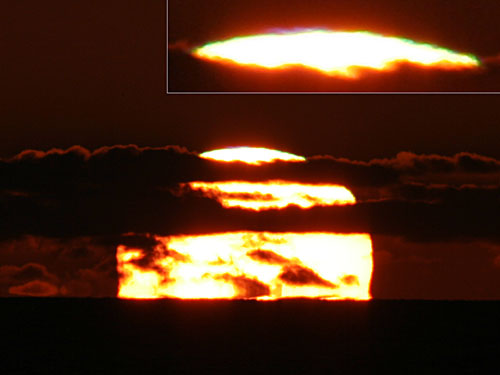|
| |
|
|
 |
|
The others pictures of "Green flash and blue flash" |
|
|
|
|
|
| 1 | 2 | 3 | 4 | 5 | 6 | 7 | 8 | 9 | 10 | |
|
|
|
|
 |
|
Green flash and blue flash |
|
|
|
|
|

|
|
|
|
|
|
|
|
|
|
|
|
|
|
|
|
 |
|
The Sun, immersed in the Atlantic to the knees, shows again a blue rim at its summit and a green rim to its right.
But it's time to explain the origine of the green and blue flashes.
The Earth's atmosphere act as a prism deflecting (refracting is the correct word) the light depending of its colro (wavelength). When the Sun is setting, one can see an image of the Sun formed by the superposition of an infinity of colored disks from red, the lower disk, to blue, the highest one. We should see the Sun disk fringed by an upper rim red to blue.
But, in reality, the atmosphere diffuse the sunlight: the blue light is much more scattered than red light by molecules of the atmosphere. This is the reason why the sky is blue. Thus, when the Sun is very low, the main part of the green and mostly blue lights has disappeared. The blue disk of the Sun is invisible and the green disk is just perceptible.
But when the sky is very clear, the scattering of green dan blue light is weaker, and it is possible to see this rim going to green to blue. So, why don't we see it? Because we are dazzled by the bright red to orange disk.
But seconds befre the Sun get under the horizon (or a far mountain), the red to orange disk has ever disappeared, an inconspicuous green fringed by a weaker blue disk remain: this is the green flash (because the blue hues are much more weaker), followed by a blue flash when the green disk has disappeared.
Generally, the blue is too scattered to be visible. So the blue flash is visible only when the sky is exceptionally clear.
This phenomenon can be magnified by a mirage: it magnify the thin green or blue rim which apprear to be taller, so much more easy to see and lasting more time.
In the following pictures, you'll see the blue disappear little by little, as the longer and longer path through the Earth's atmosphere scattered more and more the blue wavelengths. This is the reason why, at the end, only the green flash is visible, with no trace of blue hues. |
|
|
|
|
|
|
|
|
|
|
|
|
| Instrument |
|
Canon 350D + WO Megrez 480/80 (F/D 6.0) refractor |
| Exposure & film |
1/4000 s on |
| Date & place |
April 7, 2006, Tronoën (Finistère) |
|
|
|
|
|
 |
|
The others pictures of "Green flash and blue flash" |
|
|
|
|
|
| 1 | 2 | 3 | 4 | 5 | 6 | 7 | 8 | 9 | 10 | |
|
|
|
|
 |
 |
 |
|
|
A Shower of
Stars in Brittany

Brittany by night
in panorama!
|
|
|
|
 |
 |
 |
|